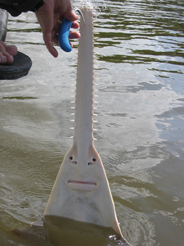It's easy to see how the sawfish
got its name. These intimidating
creatures can grow to be more than 6 meters (nearly 20
feet) long. Their bodies are flat and winged, like
underwater airplanes. And their noses are shaped like
chainsaws.
Sawfish are predators of
the sea. When a sawfish is hungry, it waves its
sharp-toothed snout through a school of fish. Then, it
lifts its nose and uses its mouth to inhale the injured
victims.
 |
|
Sawfish
like this one are related to sharks, but they
are technically rays.
|
|
Mote Marine
Laboratory
|
Hardy populations of
sawfish thrived in warm waters along coastlines around the
world for thousands of years. Over the past 200 years,
however, human actions have severely
endangered sawfish. Threats include fishing nets
that snag the huge animals, often by mistake. Compared
with other fish, sawfish reproduce late in life and at
slow rates. These
traits make it hard for them to recover from overfishing.
Some people collect
sawfish snouts as trophies: One snout recently sold for
nearly $1,600 on eBay. Shamans, or priests, in some Asian
cultures, use the toothy snouts in ceremonies to repel
demons and disease. And sawfish are also a delicacy. A
growing demand in Asia for the animal's fins for a pricey
soup has
contributed to the fish's disappearance.
New efforts now aim to
revive sawfish populations. Beginning next month, an
international agreement will provide protection for all
seven of the world's sawfish species.
Scientists are hoping
that it's not too late to save the sawfish. After all,
there is still much to learn about these dagger-toothed
animals.
Until 1998, "this
fish had never been formally studied in the United
States," says Tonya Wiley of the Mote Marine
Laboratory in Sarasota, Fla. "We didn't know such
basic things as where they live, what
habitat they use, how often they reproduce, how
many young they have—even what age sawfish are when
they" begin reproducing.
Through historical
studies and field research, scientists have become aware
of how much the fish's numbers have dwindled. Today, there
may be 90 percent fewer sawfish than there used to be.
Wiley estimates that only 3,000 to 6,000 sawfish remain in
U.S. waters.
Although there is much to
learn about sawfish, recent studies are already producing
results. For example, scientists now think that a species
called smalltooth sawfish grow for 10 to 12 years before
they first reproduce. A sawfish mom gives birth in shallow
waters during the springtime. Then she disappears, while
her young remain near the beach for months or even years.
As information accumulates,
scientists hope to find better ways to protect this unique
creature of the sea.—Emily Sohn
![]()